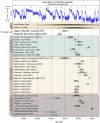Chronology of Ksar Akil (Lebanon) and implications for the colonization of Europe by anatomically modern humans
- PMID: 24039825
- PMCID: PMC3770606
- DOI: 10.1371/journal.pone.0072931
Chronology of Ksar Akil (Lebanon) and implications for the colonization of Europe by anatomically modern humans
Abstract
The Out-of-Africa model holds that anatomically modern humans (AMH) evolved and dispersed from Africa into Asia, and later Europe. Palaeoanthropological evidence from the Near East assumes great importance, but AMH remains from the region are extremely scarce. 'Egbert', a now-lost AMH fossil from the key site of Ksar Akil (Lebanon) and 'Ethelruda', a recently re-discovered fragmentary maxilla from the same site, are two rare examples where human fossils are directly linked with early Upper Palaeolithic archaeological assemblages. Here we radiocarbon date the contexts from which Egbert and Ethelruda were recovered, as well as the levels above and below the findspots. In the absence of well-preserved organic materials, we primarily used marine shell beads, often regarded as indicative of behavioural modernity. Bayesian modelling allows for the construction of a chronostratigraphic framework for Ksar Akil, which supports several conclusions. The model-generated age estimates place Egbert between 40.8-39.2 ka cal BP (68.2% prob.) and Ethelruda between 42.4-41.7 ka cal BP (68.2% prob.). This indicates that Egbert is of an age comparable to that of the oldest directly-dated European AMH (Peştera cu Oase). Ethelruda is older, but on current estimates not older than the modern human teeth from Cavallo in Italy. The dating of the so-called "transitional" or Initial Upper Palaeolithic layers of the site may indicate that the passage from the Middle to Upper Palaeolithic at Ksar Akil, and possibly in the wider northern Levant, occurred later than previously estimated, casting some doubts on the assumed singular role of the region as a locus for human dispersals into Europe. Finally, tentative interpretations of the fossil's taxonomy, combined with the chronometric dating of Ethelruda's context, provides evidence that the transitional/IUP industries of Europe and the Levant, or at least some of them, may be the result of early modern human migration(s).
Conflict of interest statement
Figures



References
-
- Kozłowski JK, Otte M (2000) The formation of the Aurignacian in Europe. J Anthropol Res 56: 513–534.
-
- Mellars P (2004) Neanderthals and the modern human colonization of Europe. Nature 432: 461–465. - PubMed
-
- Mellars P (2006) Archeology and the dispersal of modern humans in Europe: Deconstructing the “Aurignacian”. Evol. Anthropol 15 (5) 167–182.
-
- Zilhão J, d'Errico F (1999) The chronology and taphonomy of the earliest Aurignacian and its implications for the understanding of Neanderthal extinction. J World Prehistory 13: 1–68.
-
- Zilhão J (2007) The emergence of ornaments and art: an archaeological perspective on the origins of behavioural “modernity”. J Archael Res 15: 1–54.
Publication types
MeSH terms
LinkOut - more resources
Full Text Sources
Other Literature Sources

